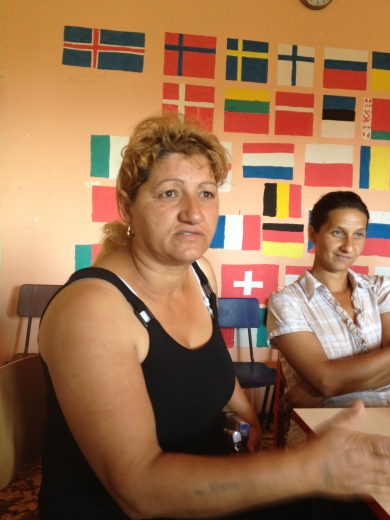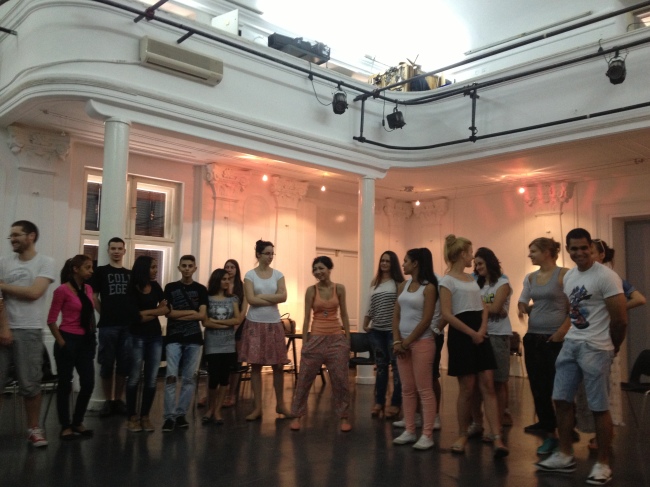By Jacqueline Bhabha, FXB Director of Research
Post-conflict Kosovo is a delicate political context, fraught with ethnic landmines. Within this complex space, the Roma, Ashkali and Egyptian communities live their own cultural and political divisions, but they are united by a common exposure to discrimination, stigma, economic marginalization and environmental harm.
Traveling the length and breadth of the small country, we spoke with parents, community members, local NGOs, international organizations, and institutions both north and south of the administrative border line marked by the Ibar River. We met returned IDPs in the Roma “Mahala” or settlement in south Mitrovica, families whose ancestral homes in Kosovo had been razed to the ground by the Kosovan Albanians in retaliation for perceived collaboration with the occupying Serbian forces during the war. These resilient IDPs- had returned “home” to new houses built by the international community in their Roma Mahala after years in makeshift camps erected on lead contaminated sites in Northern Kosovo. We met 36 Roma families still displaced from Kosovo after 14 years, living in dire deprivation, without sanitation, running water or weatherproof shelter in the tin container in Leposevic refugee camp in north Mitrovica. A member of our team commented: “These people are essentially forgotten. Most people in this camp have lived here since the end of war in poor, horrible dark corridors in small barracks located in an isolated location. Extended families live in tiny rooms within fetid, airless corridors. And yet their rooms are beautifully decorated to create a semblance of home.”
We met Roma representatives in the Serbian enclaves of Ferezaj and Gracanica; in Prizren, a flourishing multi-ethnic jewel of a town in South Kosovo near the Albanian border; and in the dusty, bustling, international agency hub of Pristina.
The Roma in Kosovo distinguish themselves in many ways from Roma living in the rest of Europe. As our Roma rights expert perceptively noted: “Issues such as political refugee status, the experience of deportation from western Europe and the return and reintegration process in Kosovo, a different economic situations, and the dual pressures of political blame and racial discrimination intersect in the Kosovar Albanian-Serbian context.” As expected, the result is a divided community and minimal political participation or educational integration by the Roma minorities. Despite a system for reserving parliamentary seats for minorities, Roma civic engagement or effective policy advocacy is stagnant. Both these failings have implications for the prosperity of the next generation.
For the Roma, Ashkali and Egyptian school-going minorities, it is the commonalities of their educational experience that are striking. They also reflect the experiences of their Roma peers in many European countries: children placed at the back of the class, low school performance, and low expectations by teachers and parents alike (though for different reasons). Teachers demand less of the Roma children, they pass onto the following grade whether their performance justifies it or not; parents lack confidence (and often competence) to supervise homework, to advocate on their children’s behalf, to provide the motivation or support required for educational success. The devastating but pervasive result: widespread “push-out” of young adolescents at the point of transition between primary and secondary school. While official figures are difficult to find, an OSCE report from 2009 indicated that a mere two Roma students were attending secondary school under the Serbian curriculum.[1] A baseline survey from the Kosovo Foundation for Open Society (KFOS – SOROS) in 2009 found that only 12% of the RAE community had finished part of or all of high school, and 2% had reached university. The same report also found that illiteracy was highest among the Roma minority (24.3%) as opposed to the Ashkali (18.4%) and the Egyptian (18.3%) communities.[2]
Our interviews highlighted some distinctive risk factors irrelevant for other European Roma adolescents. Each year for the last several years, thousands have been deported from West European countries to Kosovo to endure the most squalid living conditions. In some cases, these young people were babies or toddlers when they fled with their parents during the war, claiming refugee status in Germany, Sweden, France, the UK, and Switzerland. Despite the overwhelming evidence of massacres and grave ethnically motivated human rights violations, the majority of Roma Kosovan refugees were never granted asylum by the European host states. Rather they were awarded various types of “tolerated” temporary protection (known as “duldung” in Germany).
As peace returned to the region, irrespective of the simmering ethnic tensions and the harsh post-conflict environment, western democracies chose to send the majority of Balkan forced migrants back. Even children born in the EU countries, children who were fully integrated into their German, Swedish or French lives, were “returned” to their parents’ war torn homelands completely against their will. Reports abound of children who could speak only German or French, who had been doing well in their previous schools, now unable to enroll or adapt to completely different educational situations, to peers speaking a language they did not understand, to environments incomparably worse than those they had known in Europe.[3]
The precarious Kosovo infrastructure is also ill-equipped to cope with these particularly vulnerable returned migrants. Schools are in no position to adapt their curricula and to train teachers appropriately; the families struggle to provide required documents to facilitate to school enrollment, and housing and income emergencies simply compound the hardships. A German consular official we met argued that returned families were either welfare dependent in Germany for long periods or criminal offenders, and that in both such cases the host country was under no obligation to provide long term accommodation and support. We countered that deportation should not be an additional sanction that doubly punishes those who serve the criminal penalty meted out on nationals. Nor, we argued, should populations who have already faced the trauma of war, displacement and relocation be expected to face this again – at least not at the hands of wealthy democracies. Our disagreements reflect a broader lack of consensus on this issue.
Many of the families we met told us they could not afford secondary education, let alone university training, for their children; they had no information on scholarship opportunities and they conceded that many girls still marry before they turn 18. But all is not doom and gloom in this oppressive and unjust situation. In most of the places we visited, however dark, some rays of light shone through. In the dreadful settlement in Leposevic, we heard of a few resilient children and adolescents doing well in school, some even enrolled in secondary school; we saw children laughing, playing together, gracious and hospitable to outsiders. In the Roma Mahala in South Mitrovica we met returnee mothers trying to get skill training to advance their employment opportunities. In Pristina we heard of Roma adolescents, placed in skill training schemes, who had been permanently hired by their companies because of the quality of their work.
[1]Organization for Security and Co-operation in Europe, “Kosovo non-majority communities within the primary and secondary educational systems,” http://www.osce.org/kosovo/36978, (OSCE 2009: pg. 8.
[2] ,” Nait Vrenezi, Jusuf Thaci, ed. Blerinda Idrizi,“The Position of Roma, Ashkali and Egyptian Communities in Kosovo,” http://kfos.org/pdf/The%20Position%20of%20RAE%20Communities%20in%20Kosovo%20Baseline%20Survey_ENG.pdf., (KFOS: 2009), pgs. 34-35.
[3] “Rights Displaced: Forced Returns of Roma, Ashkali and Egyptians from Western Europe to Kosovo,” http://www.hrw.org/sites/default/files/reports/kosovo1010webwcover_1.pdf, (2010: Human Rights Watch).

